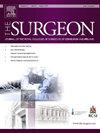The effect of forced-air warming blanket position during spinal surgery on patients’ intra-operative body temperature
IF 2.3
4区 医学
Q2 SURGERY
Surgeon-Journal of the Royal Colleges of Surgeons of Edinburgh and Ireland
Pub Date : 2024-09-19
DOI:10.1016/j.surge.2024.09.003
引用次数: 0
Abstract
Background
The use of body-warming systems is recommended by international anaesthesia societies for patients undergoing surgery. Limited research is however available on the influence of positioning of forced-air warming blankets for patients undergoing spinal surgery. This study aimed to investigate how patients’ intra-operative body temperature was affected by the position of forced-air warming blankets while undergoing spinal surgery on a spinal table.
Design
A randomized comparative experimental study was conducted with 60 adult patients undergoing posterior spinal surgery.
Methods
Patients were randomized into full underbody (n = 30) or surgical access (n = 30) forced-air warming blanket groups. Intra-operative body temperature was recorded at regular time intervals. The student's T-test, Chi-square, and MANOVA tests were performed to determine the differences between the two groups.
Results
Intraoperative hypothermia was significantly lower in the full underbody group than in the surgical access group (p = 0.020). The change in body temperature differed significantly between the two groups from 15 min until 240 min, with a mean difference of 0.5 °C.
Conclusion
The full underbody position of the forced-air warming blanket was effective for maintaining normal range core body temperature. The use of full underbody forced-air warming blanket for spinal surgery when patients are positioned on a spinal table in a prone position is recommended.
脊柱手术中强制空气加温毯位置对患者术中体温的影响。
背景:国际麻醉协会建议手术患者使用体温系统。然而,关于强制空气保暖毯位置对脊柱手术患者影响的研究却十分有限。本研究旨在探讨在脊柱手术台上进行脊柱手术时,强制通风保暖毯的位置对患者术中体温的影响:方法:对 60 名接受脊柱后路手术的成年患者进行随机对比实验研究:患者被随机分为全身下组(30 人)和手术入路组(30 人)。每隔一段时间记录一次术中体温。采用学生 T 检验、Chi-square 检验和 MANOVA 检验来确定两组之间的差异:结果:全躯干下组的术中低体温明显低于手术入路组(P = 0.020)。从 15 分钟到 240 分钟,两组体温变化差异显著,平均差异为 0.5 °C:结论:强制空气加温毯的全身下位置能有效维持正常范围的核心体温。建议脊柱手术患者在脊柱手术台上采取俯卧位时使用全身下强制空气加温毯。
本文章由计算机程序翻译,如有差异,请以英文原文为准。
求助全文
约1分钟内获得全文
求助全文
来源期刊
CiteScore
4.40
自引率
0.00%
发文量
158
审稿时长
6-12 weeks
期刊介绍:
Since its establishment in 2003, The Surgeon has established itself as one of the leading multidisciplinary surgical titles, both in print and online. The Surgeon is published for the worldwide surgical and dental communities. The goal of the Journal is to achieve wider national and international recognition, through a commitment to excellence in original research. In addition, both Colleges see the Journal as an important educational service, and consequently there is a particular focus on post-graduate development. Much of our educational role will continue to be achieved through publishing expanded review articles by leaders in their field.
Articles in related areas to surgery and dentistry, such as healthcare management and education, are also welcomed. We aim to educate, entertain, give insight into new surgical techniques and technology, and provide a forum for debate and discussion.

 求助内容:
求助内容: 应助结果提醒方式:
应助结果提醒方式:


